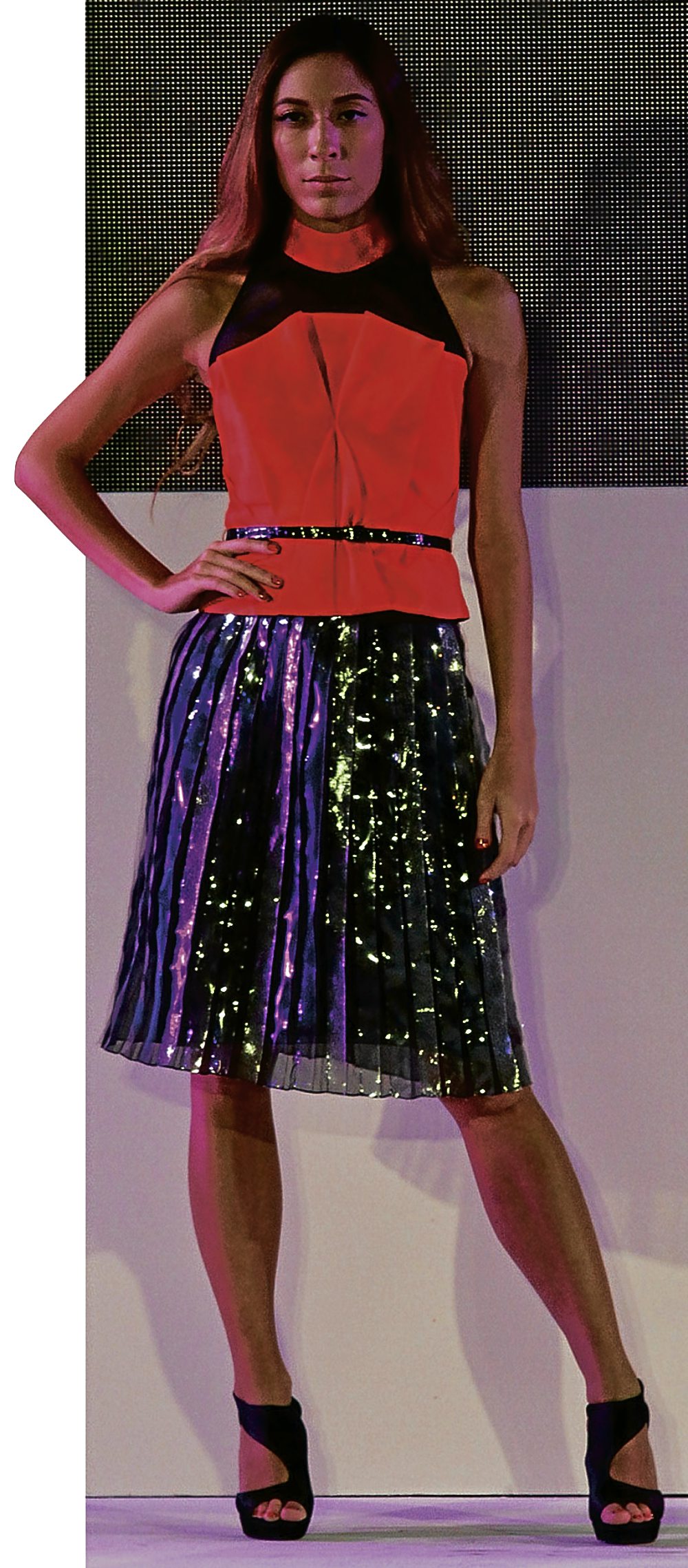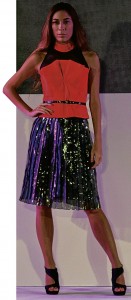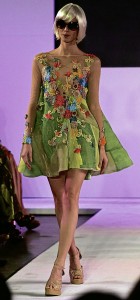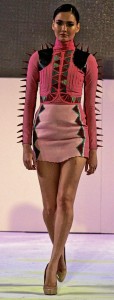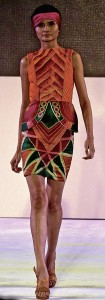Roland Alzate, 27, this year’s Look of Style Awards winner, was feeling confident that his five-piece collection made from a combination of new and recycled materials sourced from old dresses and leather jackets would blow away judges.
But after seeing the entire field during last week’s deliberations, Alzate wasn’t so sure anymore. Apart from producing wearable and striking pieces, the 10 finalists made use of various innovative techniques and materials, from seeds and wax dyes to fabrics made from recycled plastic bottles, in keeping with the contest’s eco-chic theme.
Now on its third year, the Look of Style Awards has gone nationwide. It is staged every year by Inquirer Lifestyle and Look magazine with the British Council. Leading this year’s sponsors was L’Oreal.
Aside from Alzate, this year’s finalists from Manila were Vania Romoff, Renan Pacson and Roxanne Hoey. Hanz Coquilla, Rey Villegas and Mike Yapching represented Cebu, while Jun Artajo, Ivan Raborar and Joao Tarepe represented Davao.
“After seeing their pieces, I realized how talented and creative Filipinos are,” said Alzate. “Everyone did something special using all sorts of amazing materials. I can’t claim to be the best.”

But judges, led by Amanda Burrell, country director of the British Council, saw obvious merits in Alzate’s work that tipped the contest in his favor.
The other judges were designers Lulu Tan Gan, JC Buendia, Amina Aranaz-Alunan, Jane Bowler, and journalists Stef Cabal, editor in chief of Look Magazine, Cheche Moral and Mel Cuevas.
Bowler, a London-based British designer, also showed some pieces, which preceded those made by the contestants.
London scholarship
As part of his prize, Alzate will receive an all-expense paid trip to London sponsored by the British Council to attend a one-week fashion design course at the prestigious Central Saint Martins.
Previous Look of Style Awards winners such as Pablo Cabahug and Geof Gonzales also took the once-in-lifetime scholarship.
Alzate, who first studied fine arts at the Saint Louis University in Baguio before shifting to marketing, will also get mentoring from fashion industry professionals on business planning and marketing. He’s also assured of a spot in Inquirer Lifestyle’s next Face-Off fashion show.
Barely a year after he began designing professionally, Alzate is on a roll. He also won the top prize last year in “Weaving the Future,” a contest organized by the Fashion Design Council of the Philippines (FDCP).
“The competition was really tight, but some of my colleagues probably didn’t have access to the best finishing,” he said. “I’m lucky in that area. Apart from the fit, I made sure that my clothes are sewn, tucked and ironed well.”
Alzate, who apprenticed under seasoned designer Noel Crisostomo for almost two years before striking out on his own, also learned the importance of editing from his mentor.
“Before I buckled down to work, I was so excited that I wanted to do everything,” he said. “Then I remembered Noel’s constant reminder to me on the importance of editing. Being more selective helps you produce a more cohesive collection.”
Judgment day culminated in an evening fashion show and awarding at the Rockwell Tent in Makati, where competing designers showed three of their best pieces.
Three distinct looks
Alzate presented short, fitted dresses with three distinct looks. His strongest piece was a cream and pink number made of piña and rayon following Aklan’s ringge weaving technique.
“I didn’t want to produce a collection that would alienate the mainstream. My goal was to make my clothes look salable yet fresh,” he said.
Alzate worked with the same group in Aklan that produced his so-called piña-poly fabric, which he used for his winning collection in the FDCP contest. This time, he asked them to produce “something more chic.”
Details were confined to the dress’ lower half, which echoed the look of woven solihiya. Unlike the bottom part, which was made of piña and rayon, the top part was made from jusi recycled from an old wedding gown.
His first piece, a beige number, had a multicolored leather patchwork on the bodice, while his second piece, an orange and black dress with an electric-pleated skirt, had a plastic overlay on the skirt.
“I made use of old leather jackets to produce the patchwork,” he said. “Since I had conceptualized the look long before Lesley Mobo did a show in Manila, the plastic overlay has nothing to do with his use of a plastic-looking material in some of his pieces.”
Primitive yet modern
Yapching, Raborar, Romoff and Artajo also made quite an impact on the ramp.
Channeling an Aztec deity, Yapching produced what he described as a “Filipino collection out of a foreign” civilization that “looks primitive with a modern touch.”
Done in garnet red muslin with touches of black, maroon and teal, the collection was noteworthy for incorporating cross-stitching and the use of unconventional materials such as fused plastic, sawdust chips and clay spikes.
“Muslin is cheap and durable and can be treated in many different ways,” he said. “I also used patches of used garbage bags that looked like leather and fused plastic bags as pockets. Cross-stitching, which proved to be the hardest part, was a major factor, as I wanted to create embroidery that didn’t require energy.”
Raborar also ventured beyond his comfort zone by ditching t’nalak, one of his favorite materials, in favor of crocheted pieces in the form of a short dress, hot pants and jumpsuit.
To emphasize the ’60s-inspired collection’s resort feel, Raborar accented the airy teal pieces with beads. He did them the old-fashioned way by tapping women to manually work on his materials.
“In keeping with the theme, I didn’t use any machine,” he said. “I also didn’t resort to ready-made materials. The crocheting was all done by hand. One of my goals is to bring back such crafts, and push them to the mainstream.”
Known more for her chic designs steeped in Western sensibilities, Romoff went the other way by embracing t’nalak, and fashioning it into loose, unstructured coat dresses that fused tailoring with draping. Her last piece drew heavily from the Indian sari.
Vinta inspiration
Artajo, a bridal wear designer, also did away with the usual soft and luxurious materials he usually uses in favor of hand-painted piña jusi combined with silk cocoon.
Drawing inspiration from the colorful vinta, he used wax and organic dyes in gradating shades of emerald green and orange to produce modern batik-printed tailored and pleated dresses with a ’40s silhouette.
Tarepe, Coquilla and Villegas used a great deal of retaso or scrap fabrics to produce their respective collections.
Tarepe’s black-and-beige pieces, for instance, incorporated scraps of piña with canvas and coconut shells. He resorted to hand-weaving to achieve a banig-like effect, which reminded him of his childhood while growing up in Surigao.
“The most challenging part was how to achieve a modern and classy look by using materials most designers would normally ignore because they find them cheap,” he said.
Villegas also used scraps of piña he dyed in various shades of green before fusing them like a jigsaw puzzle to create loose dresses. He accented each piece with cut lace in various colors for more visual impact.
Coquilla’s fascination with his native Cebu’s coral reefs was reflected, he said, in his smocked blue-gray pieces made of scraps of fabrics and a bit of lace. He got the scraps from a foreign company based in Cebu City.
“I’m drawn to corals, but my fear of the water has stopped me from getting close to them,” he said. “I tried to make my version through these pieces.”
Most innovative
Finally, Pacson presented arguably the evening’s edgiest and most innovative pieces. From his collaboration with the Philippine Textile Research Institute, the designer was able to produce a fabric made of 100-percent recycled plastic bottles.
His main inspiration, an imaginary Japanese tribe that survived the nuclear bomb that ended World War II, was equally disturbing. Because of oxygen deprivation, they developed blue-baby syndrome, he said, which explains Pacson’s ashen blue color palette.
“One particular jacket is inspired by the pattern used in a traditional Japanese kimono,” he said. “The same applies to one of my dresses. What makes the pattern special is it employs zero-waste technique.”
His post-apocalyptic peg extended to his styling, which included a black scarf that nearly covered his models’ entire faces. In lieu of recycled plastic bottles, the accessory was made of piña organza appliquéd on the interior part of an old tire.
By opting to do separates like jackets and skirts that the market could easily relate to, Pacson believes that he’s one step closer to achieving his vision of creating “sustainable fashion.”
“If we could make the masses understand the importance of recycling, then awareness would be more widespread,” he said. “And what better way to raise awareness than by offering them recycled products through pieces which they could actually use again and again in their everyday lives.”
PHOTOS BY JIM GUIAO PUNZALAN AND ALANAH TORRALBA

